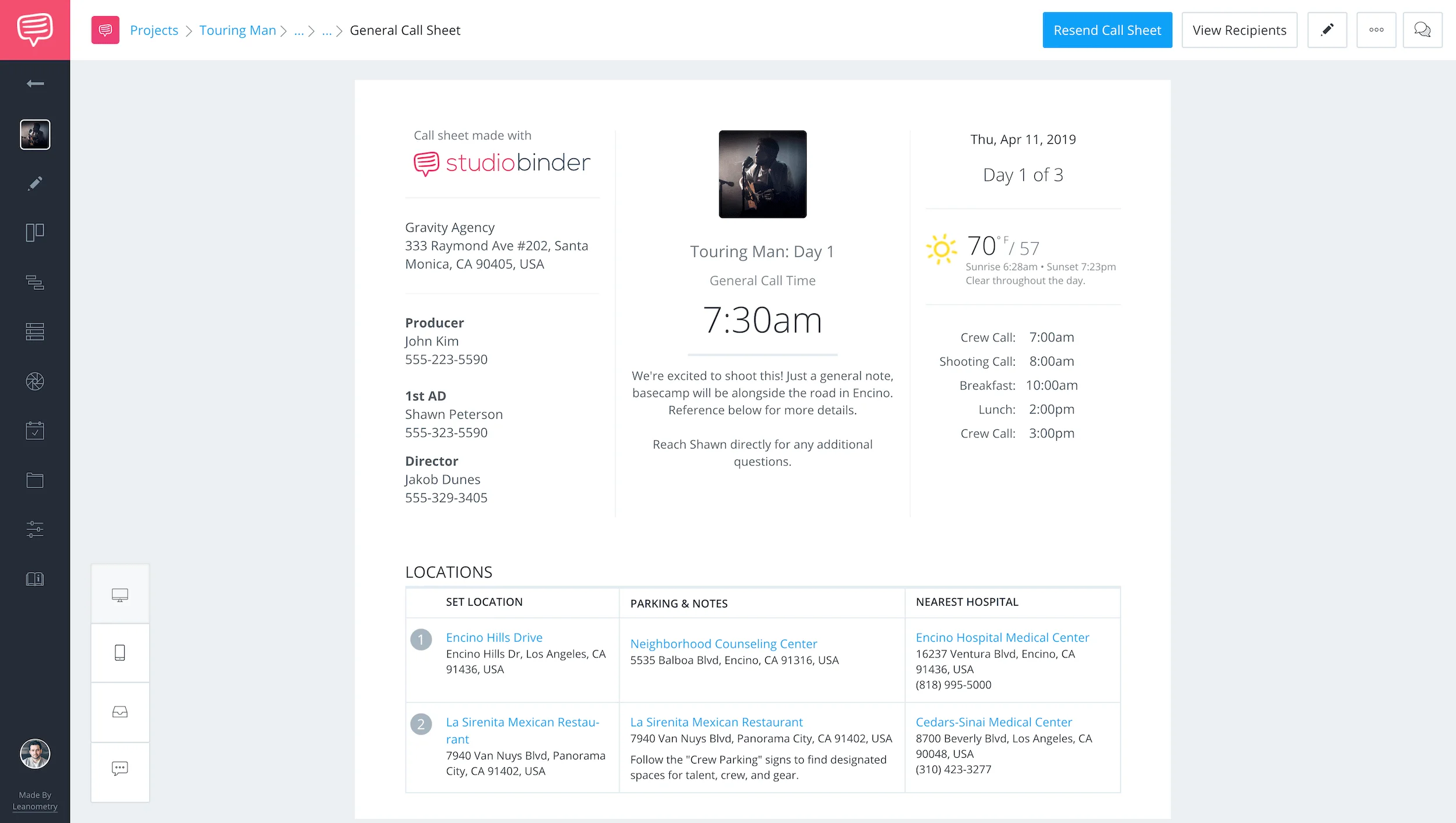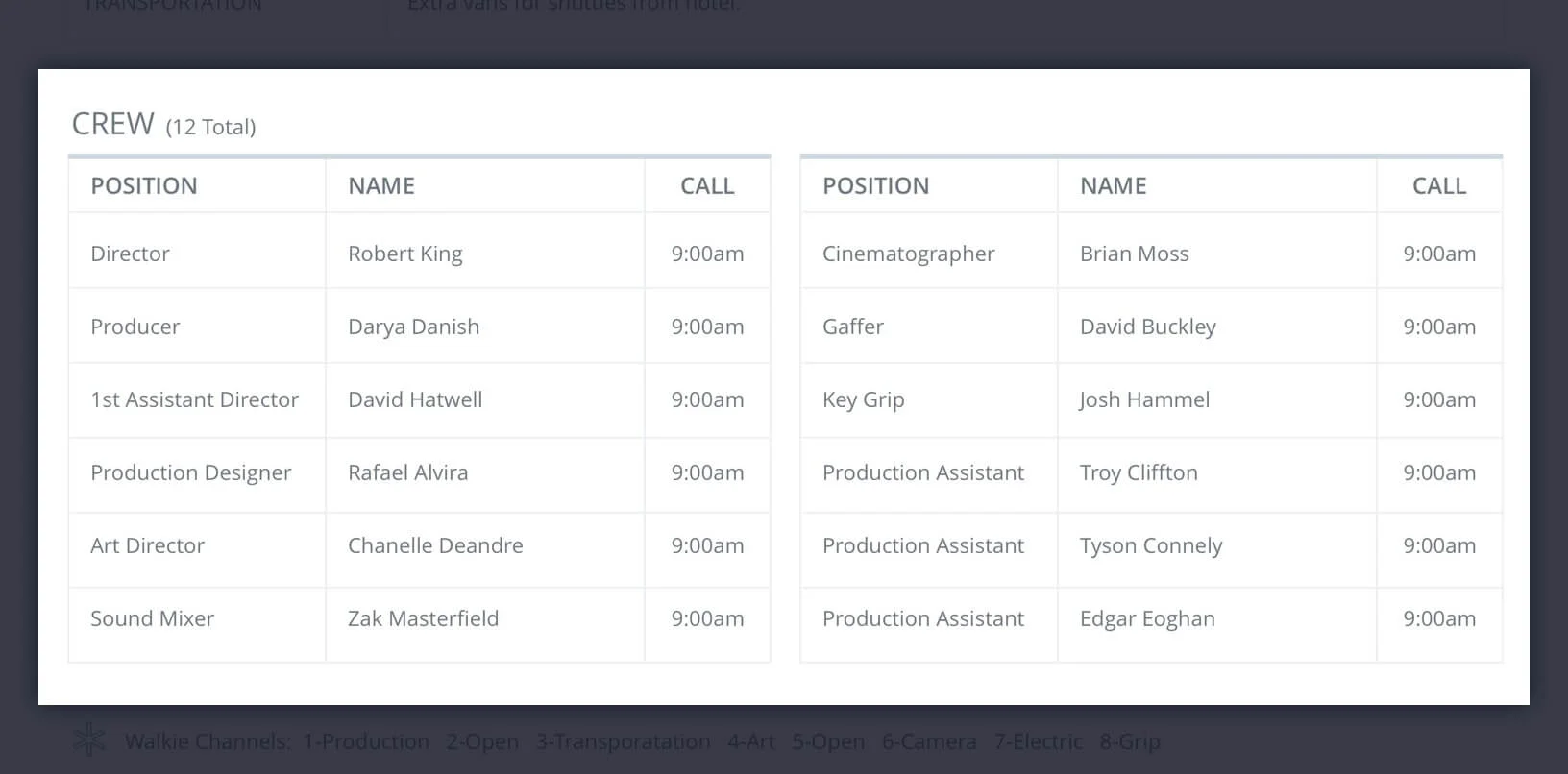What exactly goes into call sheet? Which producer’s names go on the top? Where do you put the parking details? Is the lunch menu listed?
Fret not, gentle reader.
We had a chance to interview 1st AD Alex Stein to discuss the anatomy of a call sheet. In this article (and video), Alex Stein breaks down all the components that should be included in a standard call sheet for film and television.
call sheet for film
Quick primer on how to make a call sheet for film
The daily call sheet is a filmmaking term for the schedule implemented by the assistant director (AD), using details from the shooting schedule and shot list associated with each scene that will be filmed that day. The callsheet is send to the cast and crew of the film production to let them know about where and when the filming is going to take place.
What's in the call sheet?
Planning your shoot means anticipating your needs before you get to set. The call sheet isn't just a tool to tell your cast and crew what time to be where, but also to prepare for the unexpected. Weather conditions and nearby hospitals are a must on the call sheet, and parking rules and regulations are another, less dire, but appreciated practice.
There is a lot to remember when building a call sheet, so StudioBinder has taken the liberty to make your life easier with its call sheet template. If you forget what goes on the sheet, don't worry. Everything you need is laid out for you. Your only job is to plug in your specific information.
Take a look at a free call sheet builder below.
A clear communicated call sheet is the lifeline for shoot days. It's critical to curate the most efficient one possible. If you're not already familiar, explore the ins and outs by taking a look at the image below.
Film Callsheet templates
StudioBinder's Feature Film Callsheet Template
Right-click and save the high-res feature film callsheet image.
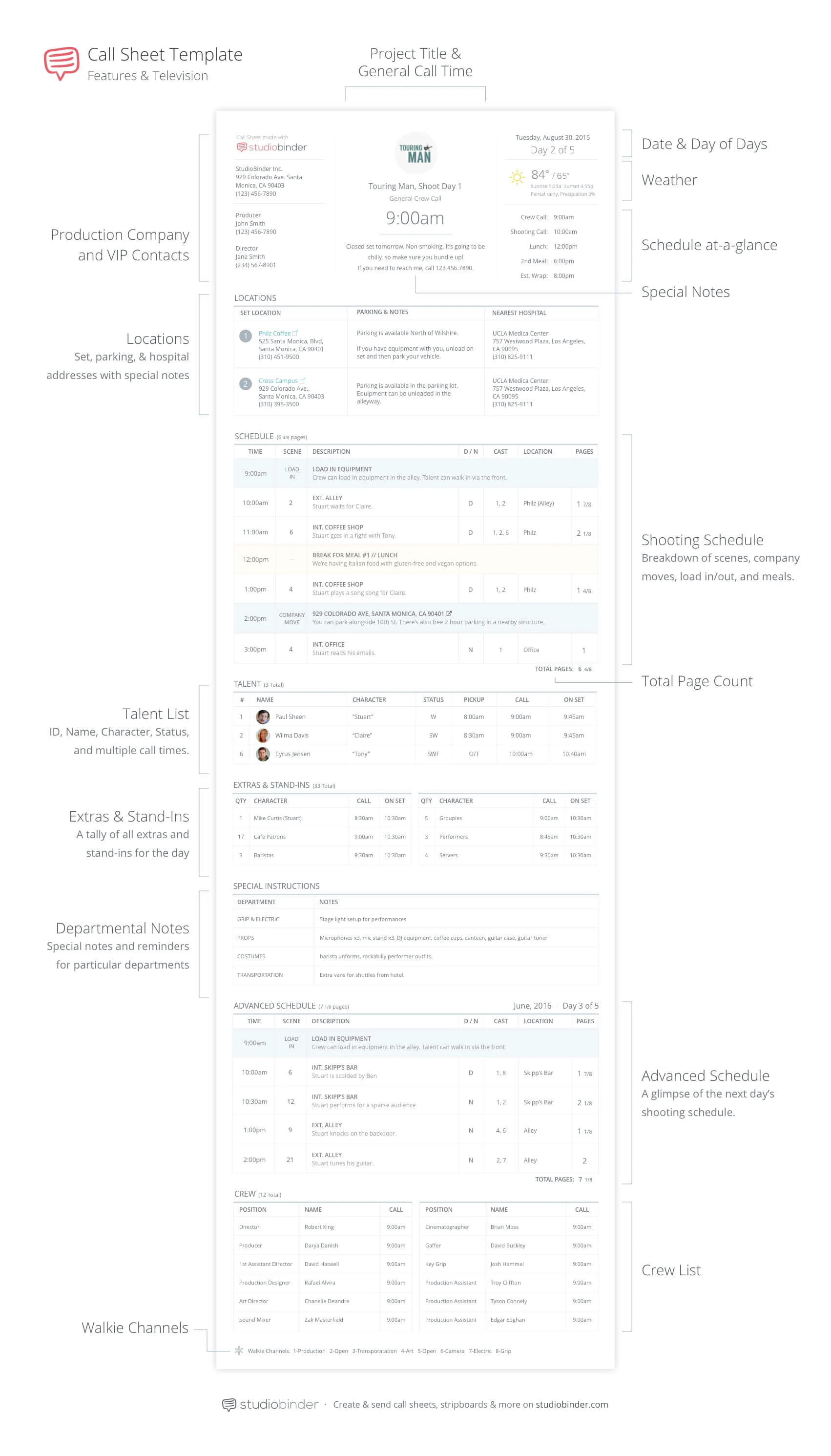
StudioBinder’s Feature Film Callsheet Template
How to Make a Call Sheet inside StudioBinder
Film call sheet Components
1. VIP contact details
At the top-left corner of a call sheet, you can usually find the production company logo, production office details, and VIP contacts (i.e. director, producer, 1st assistant director, etc.). If a talent or crew member needs to get in touch with someone ASAP, this is where they’d look first.
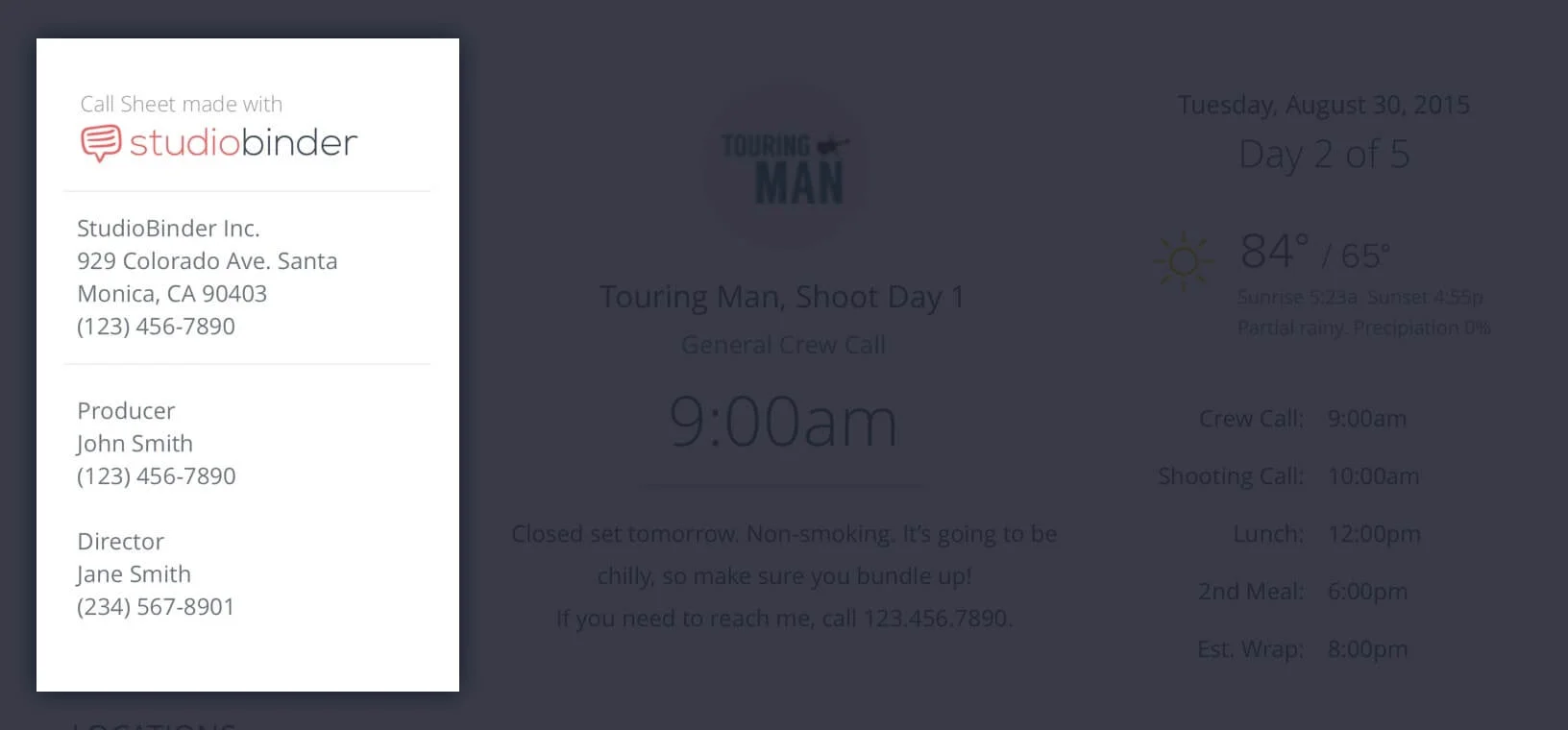
StudioBinder auto-imports your contacts onto the call sheet
Film call sheet example
2. Production title & crew call
Every call sheet needs to have the title of the production and general crew call time prominently placed near the top. If you have a special announcement to highlight, this is a great place for it.
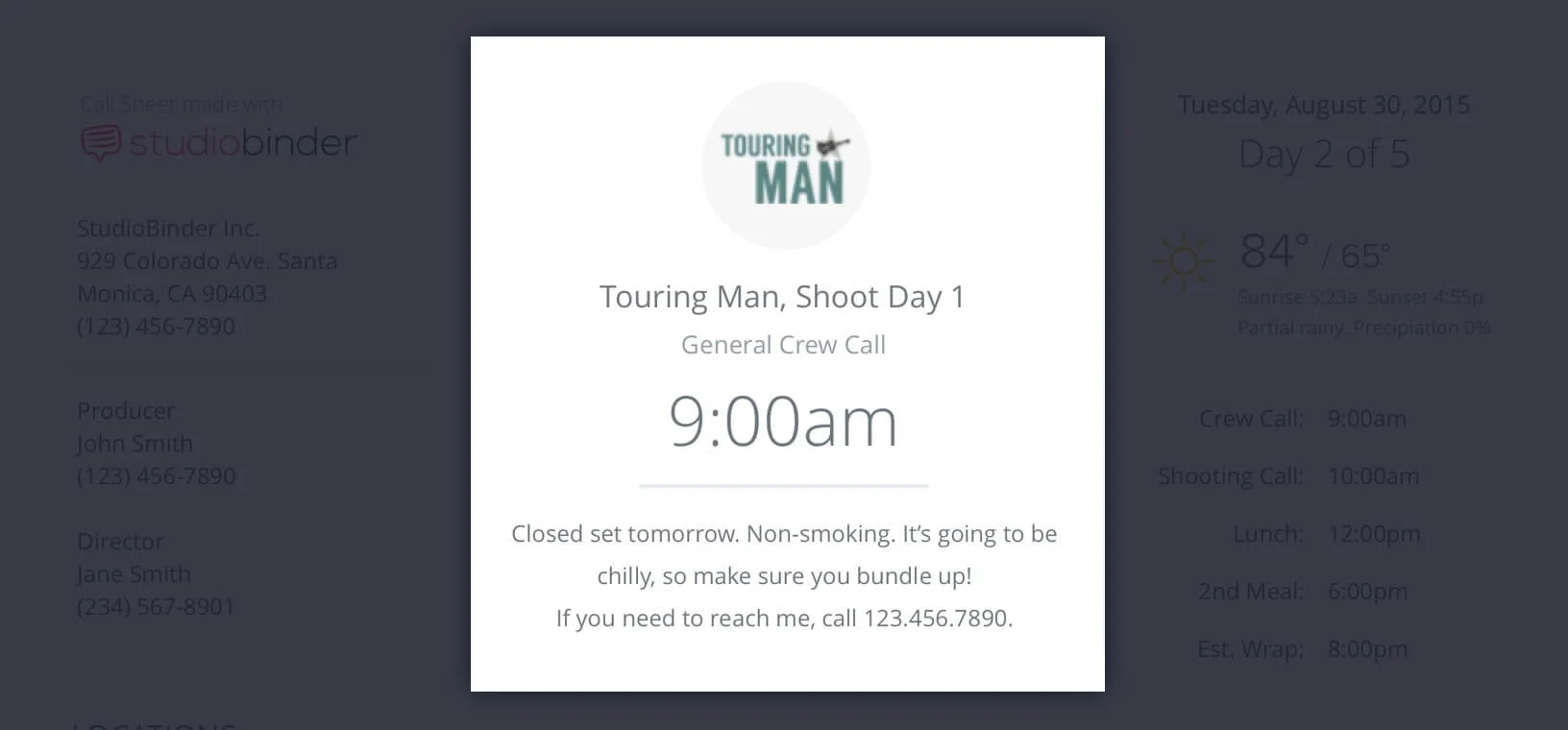
Your general crew call should be large and in charge
Video call sheet template
3. Date, day-of-days & weather
Usually near the top, you’ll find the date and what day of the shoot you’re on, known as the Day Out of Days report.
Weather is also placed in this vicinity, and indicates high/low temperatures, sunrise / sunset times, and other details.
Some call sheets, particularly more robust, feature film call sheets (like the template we developed for StudioBinder) may summarize the day’s schedule up top and call out key times like Shooting call, Meal Breaks, and Estimated Wrap.
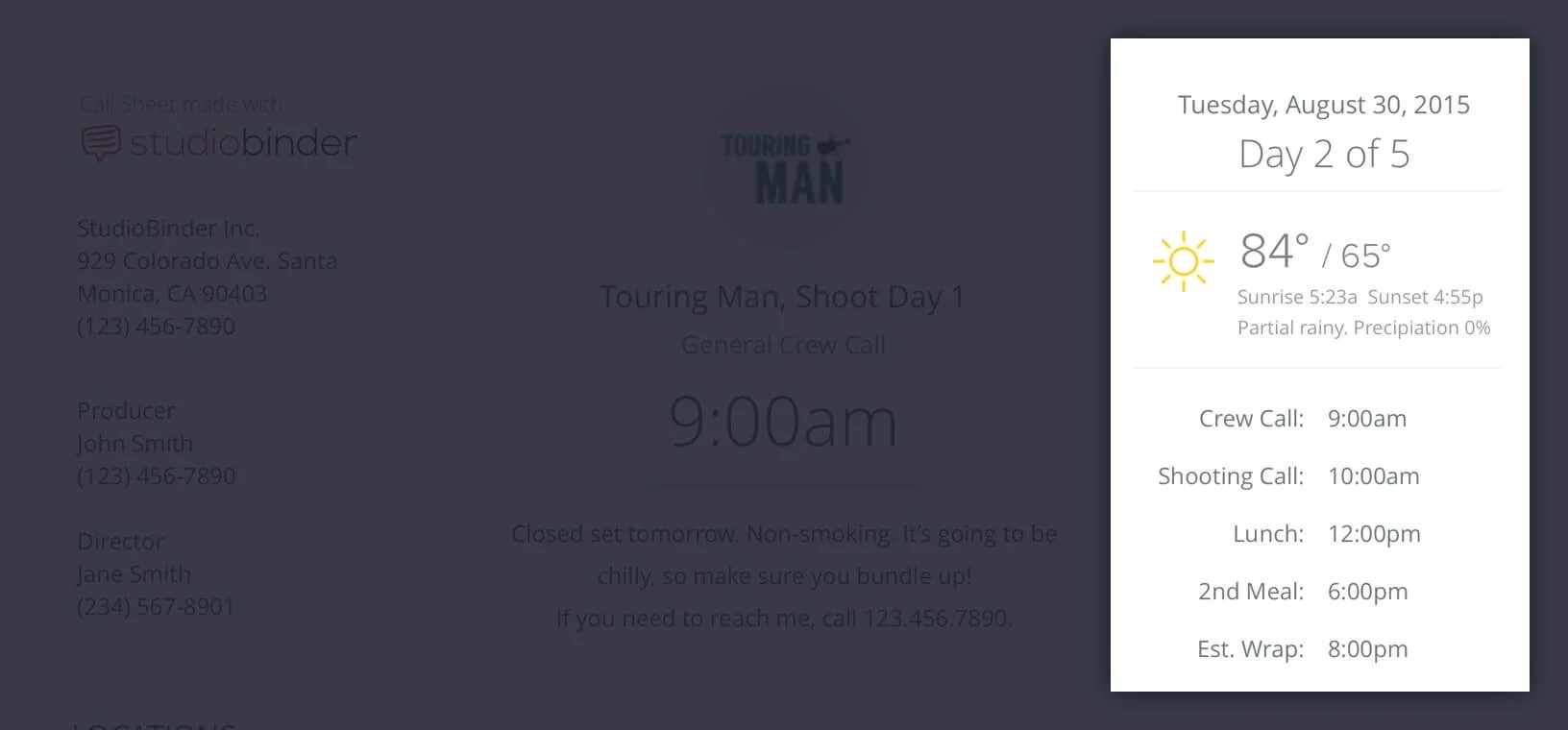
StudioBinder auto-adds the weather, sunrise and sunset times
Related Posts
feature film call sheet Template
4. Set sddress, parking & hospitals
Locations are often stated near the top half of a call sheet. If there’s more than one location, label each with a number (i.e. “Location 1,” “Location 2,” “Location 3” etc.).
Also include the address for parking since it is usually different than where you’ll be shooting. If there are any notes about parking, driving directions, or shuttles, this is where you would include it.
Regardless of production scale, always include the location of the nearest hospital to each location. The only time you’ll need be looking this up on the callsheet is when you have a serious emergency on set, so it’s important.
Double check to make sure your call sheet lists a full hospital with an 24 hour emergency center (not just a local clinic).
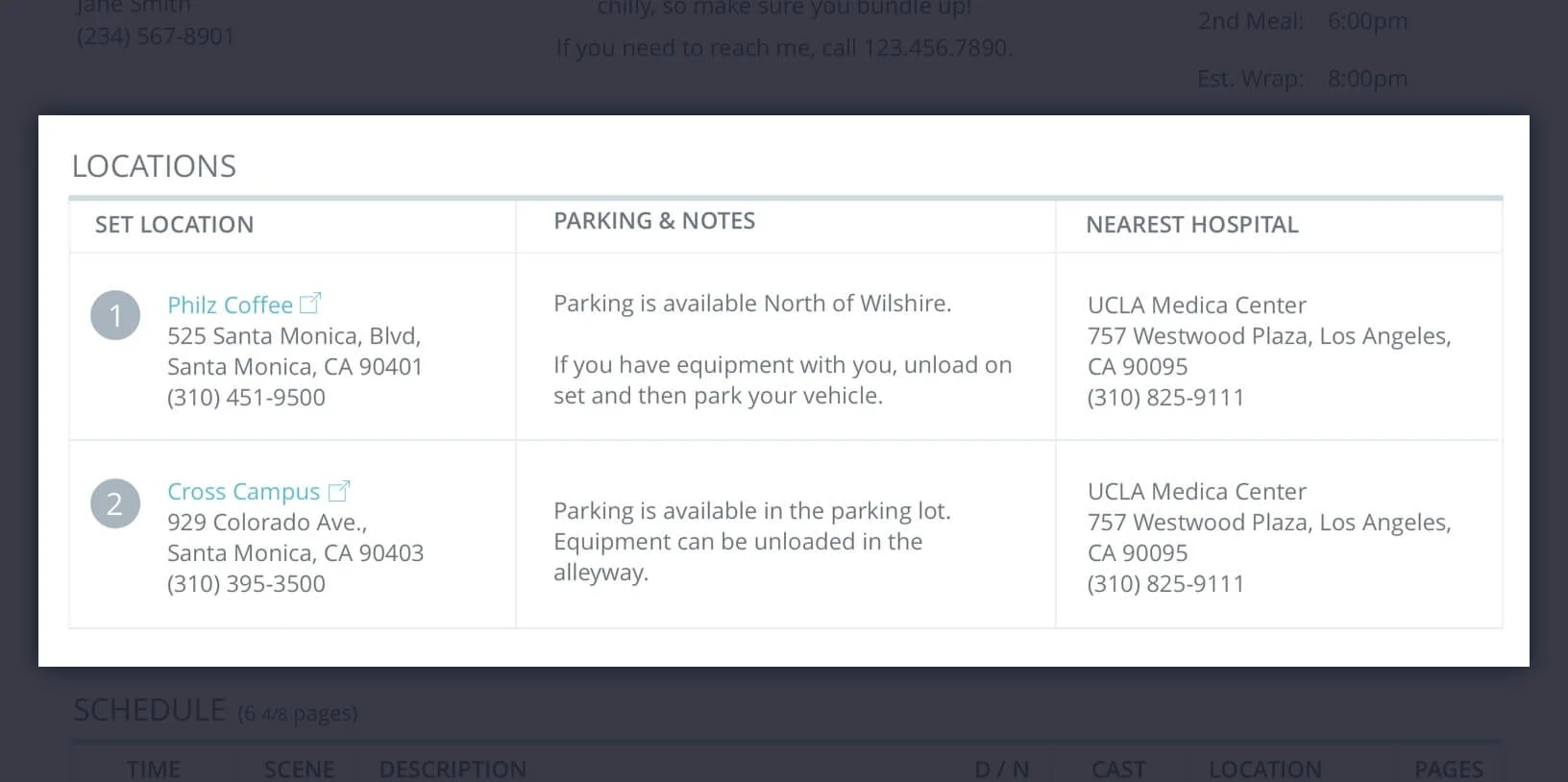
StudioBinder automatically lists the nearest hospital based on location
film call sheet
5. Daily shooting schedule
The next major chunk of a call sheet is dedicated to what you’re actually shooting for that day. At the bottom, sum up all the pages to get a total page count for the day. A typical, dialogue-driven indie film shoots about 5 pages per day.
WHAT GOES ONTO A DAILY SHOOTING SCHEDULE
- Scene Number
- Scene Heading from Script
- Notes regarding the scene (i.e. key props, stunts, prep, etc.)
- Day or Night scene
- Performing talent in the scene (Character ID)
- Location in the storyline
- Page count for the scene
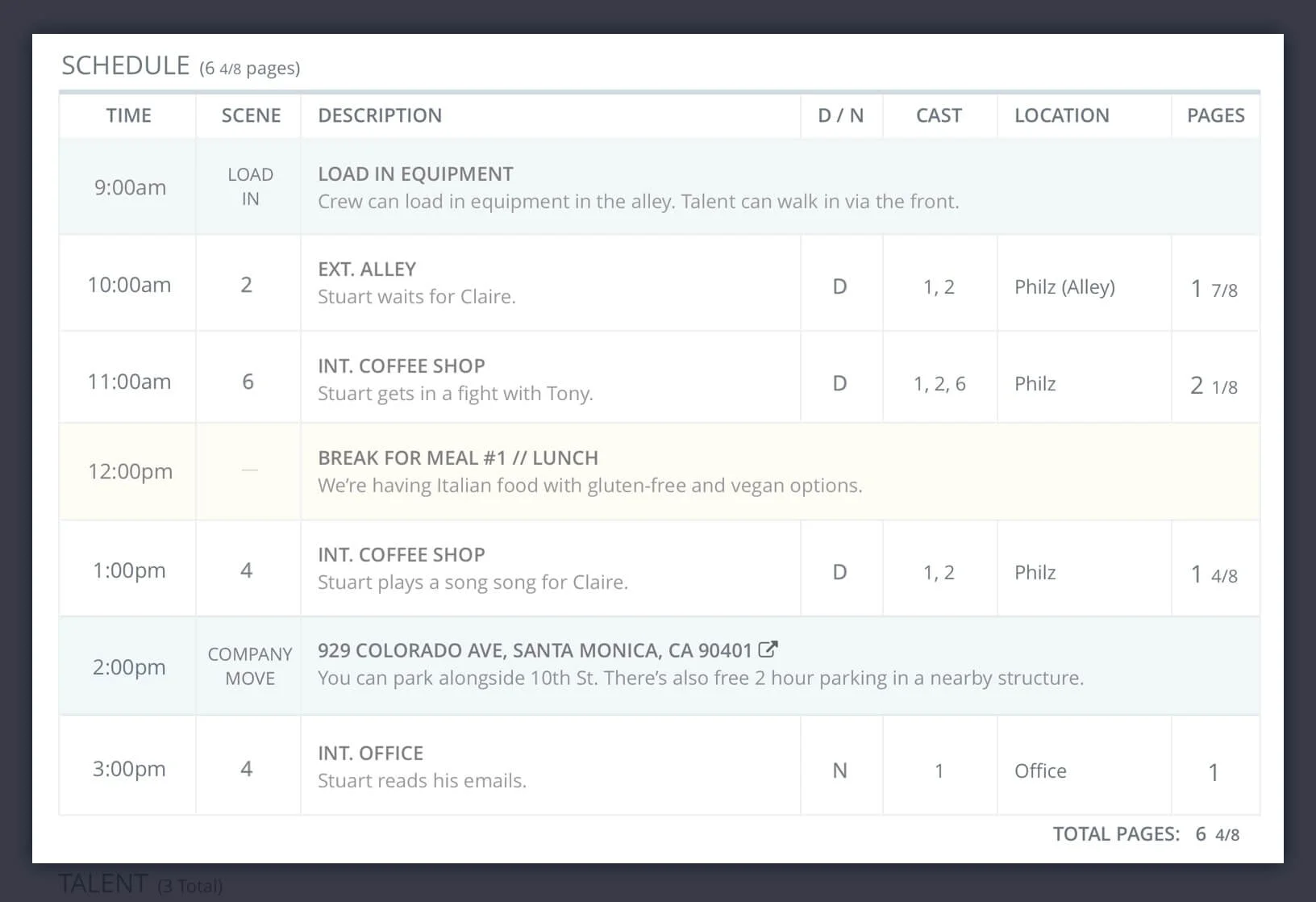
Daily Shooting Schedule
PRO TIP: MEALS AND COMPANY MOVES
Don’t forget to include what time lunch will be served!
According to union rules, a full meal must be served no more than six hours from the general crew call. If you have any company moves, add them as well (include time, address, and parking notes). StudioBinder colors schedule notes and company moves yellow and blue respectively.
Free Film call sheet template
6. Talent list
Below the schedule for the day, you can find there will be a section that indicates talent call times for the day. This area typically has the talent’s name, character ID number (i.e. 1, 2, 3, etc.), character name, status, and call times.
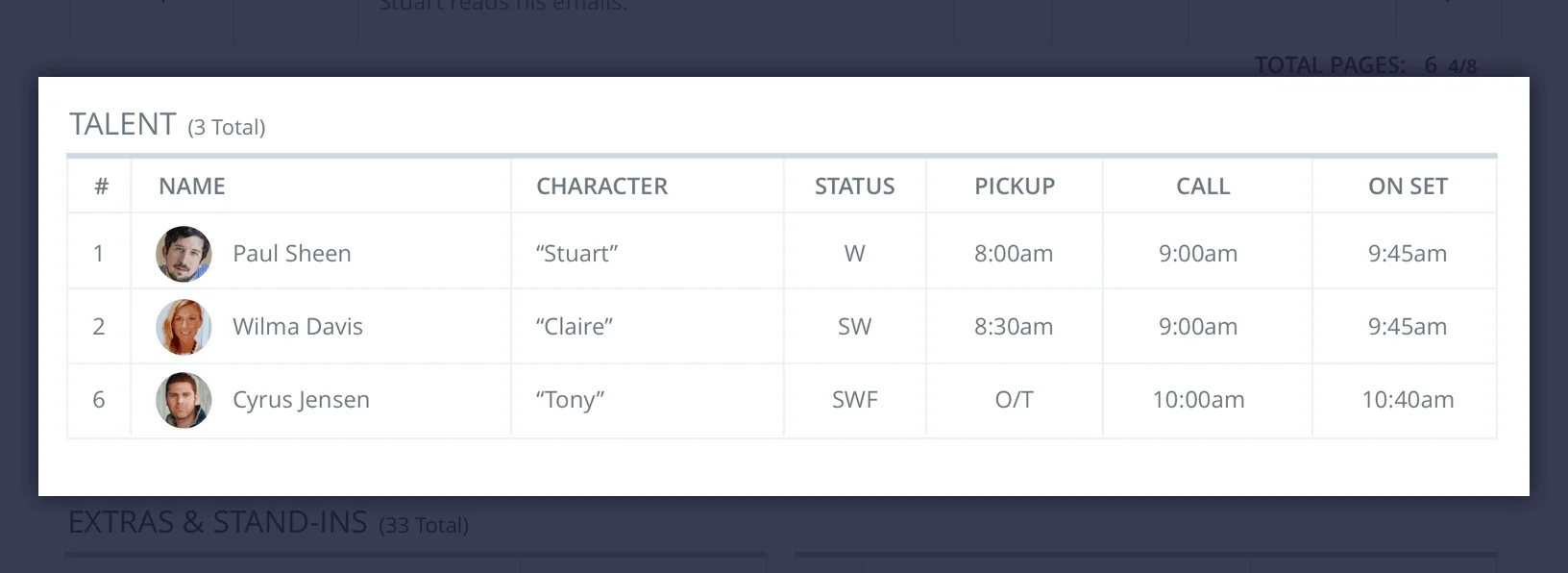
Talent List
WHAT DOES STATUS MEAN ON A CALL SHEET?
The status column indicates the length of the talent’s job on a multi-day project. The column is populated with a combination of the letters S, W, H, F, which stands for Start, Work, Hold, Finish.
- “SW” stands for “Starts Work,” and means it is the talent’s first day on the job.
- “W” stands for “Works,” and it means your talent is in the midst of their job.
- “WF” stands for “Work Finish,” and it means it is your talent’s last day on the job.
- “SWF” stands for “Start-Work-Finish,” and it means your talent will work for just that one day.
- “H” stands for “Hold,” and it means that your talent is not being used that day.
WHAT DOES PICKUP AND ON SET MEAN ON A CALL SHEET?
Pickup indicates what time talent will be picked up for transport to set. This is most often used when talent is shooting away from home, and will be shuttled from their hotel lodging.
On local projects, talent may drive themselves to set. In this case, you can leave the pickup column blank or enter O/T which stands for “Own Transport.”
The “On Set” call time column indicates what time the talent must be finished with makeup / wardrobe, and report to set for performance.
anatomy of a call sheet
7. Background & stand-ins
The extras list features a headcount of all the extra ‘types’ that will be coming in that day along with their call times.
So for example, if you’re shooting a scene that takes place in a Cafe, you could have 17 extras playing cafe patrons, 3 baristas, 4 servers, etc. You then add up all of the extras to get a total head count. This informs the production unit, make-up, wardrobe, catering, assistant director (etc) of the number of extras that will need to be maintained that day.
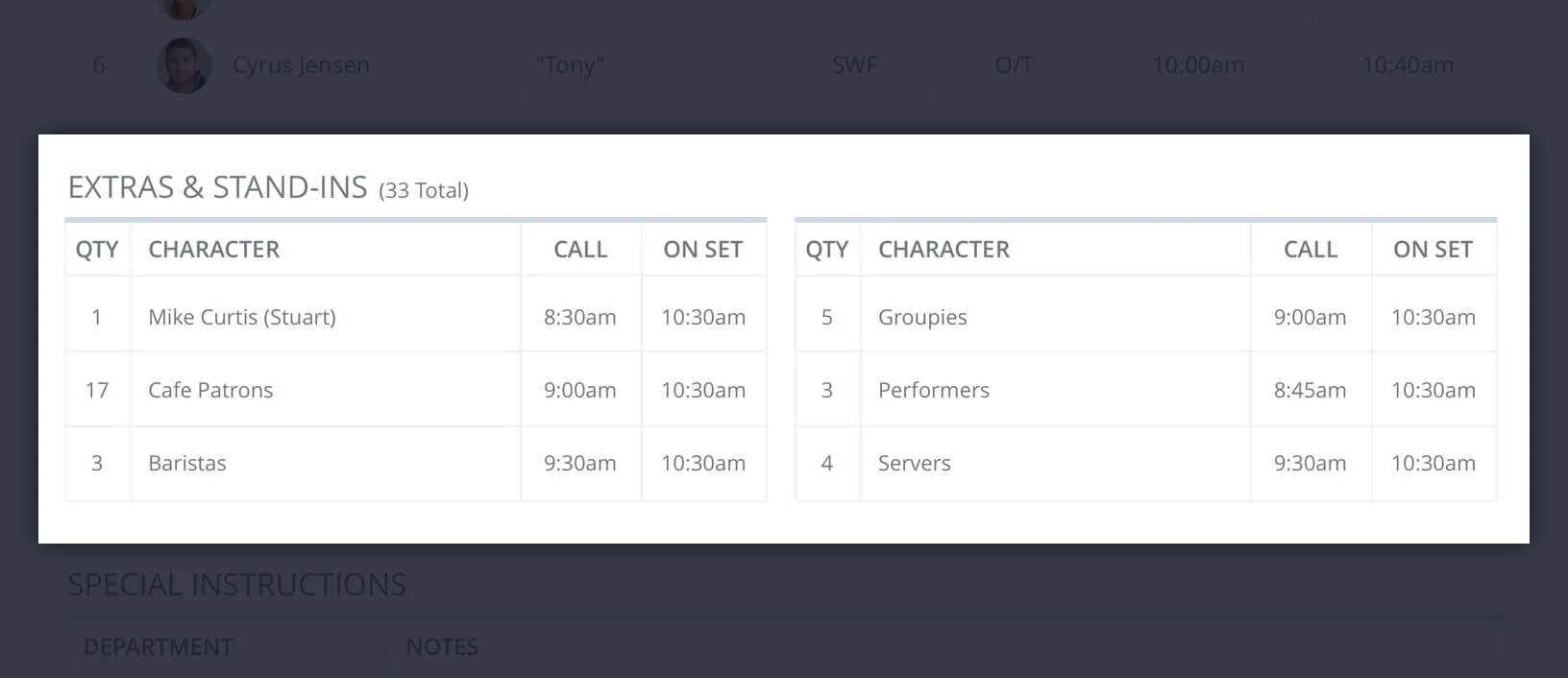
Extras and Stand-ins
A stand-in or stunt person, is someone that that stands in for major talent when their face is not featured on-camera, or when they’re not performing their own stunts. Similar to extras, they usually have one or two call times. However, a stand-in or stunt person’s name should be stated along with the name of the talent or character they are standing in for.
call sheet sections
8. Department notes
In most call sheets, you’ll need an area to highlight specific notes for departments. These notes can be anything; key props in the scene, wardrobe, a note regarding a complicated lighting setup, or a reminder to bring something to set (i.e. paperwork). You get the idea.
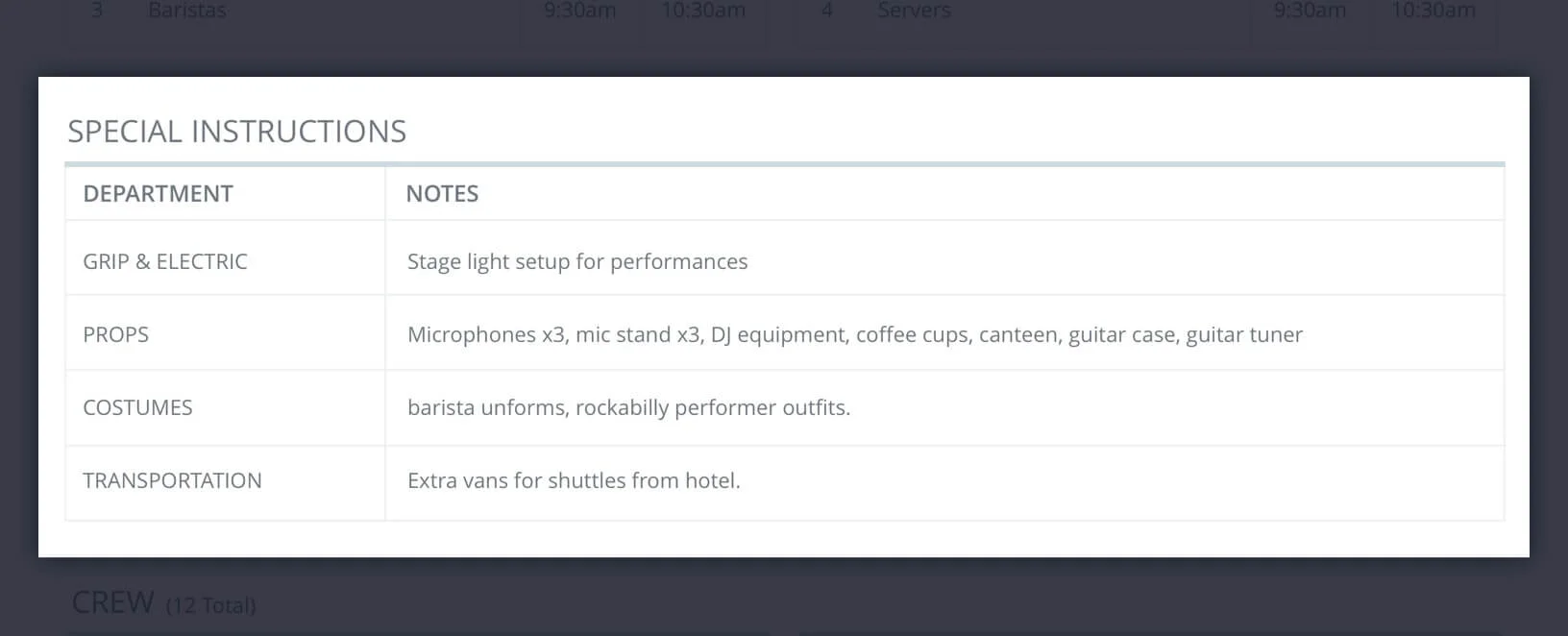
Set up an organized communication system for gathering notes
call sheet essentials
9. Crew list
After talent, you can add a list of all the crew members in attendance that day. Usually all you need is their position, name and call time. Some productions like to include contact details as well.
In StudioBinder, you can easily set custom call times for each crew member
critical components of call sheets
10. Advanced schedule
An advanced schedule is essentially a preliminary shooting schedule for the next day. This is not always necessary (as changes are made daily to the shooting schedule), but it’s helpful in many cases to provide the talent and crew an idea of what’s coming up on the next day of the shoot so they can prep.
The advanced schedule looks exactly like the schedule featured above (see point #5), but to avoid confusion, it is labeled “Advanced Schedule” with the corresponding date and appropriate day-of-days.
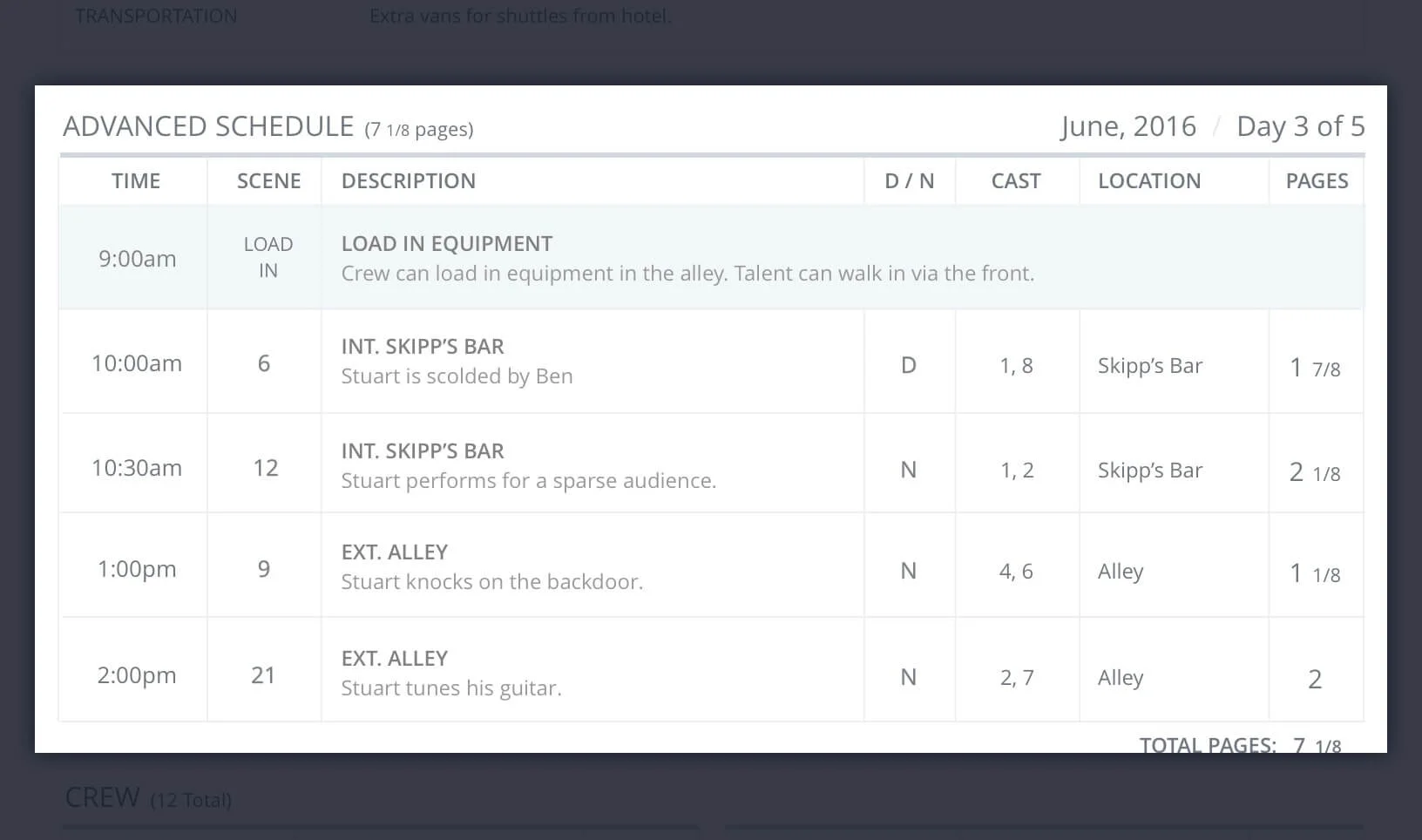
StudioBinder breaks your script into 1/8 pages, the industry standard for shooting
components of call sheets
11. Walkie talkie channels
You can add walkie channels in the footer or general notes of a call sheet.
Although there are industry standards for which channels to use for certain departments, sometimes channels may vary by production so it’s best practice to have them listed out on the callsheet.

Walkie Talkie Channels
Related Posts
building a call sheet
Make a call sheet in 60 seconds
If you’re looking to create a call sheet, you can create it either do it in Excel or use free production management software like StudioBinder.
Call sheets can now be turned around much quicker online. Weather, map links, and hospitals can be filled in automatically. Recipients receive personalized text messages to avoid information overload and confusion. They can be viewed nicely on smartphones for talent and crew on-the-go. Using call sheet software provides full visibility to when (or if) call sheets are viewed.
StudioBinder is Free to Get Started →
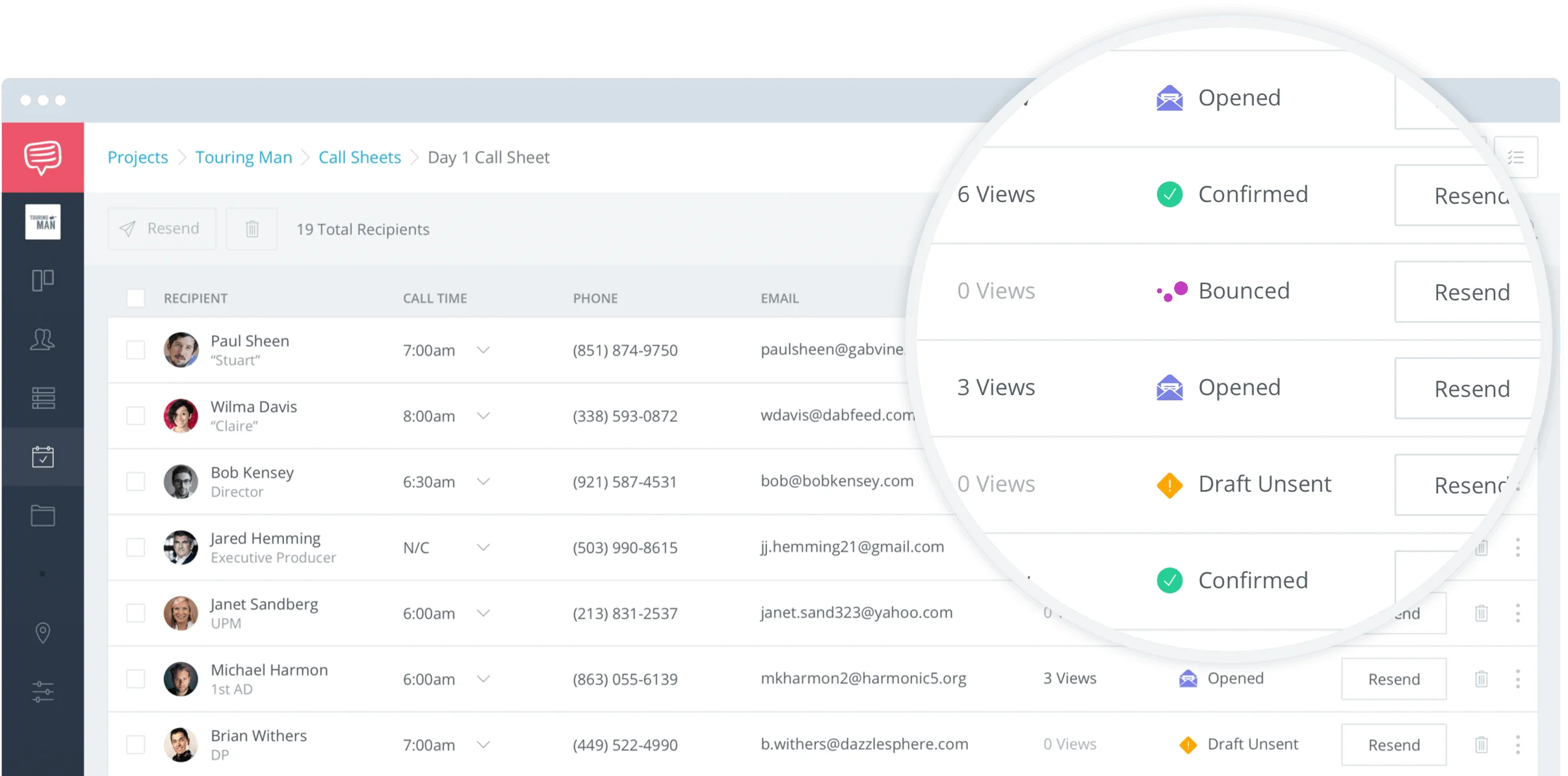
Call sheet status updates
up next
Call Sheet Approval for Commercials
We hope this was a helpful post on the anatomy of a call sheet. But what do you do once a call sheet has been created? Learn more about How Teams Approve Call Sheets on Short Form Projects. And, as always, let us know what you think in the comments below!

